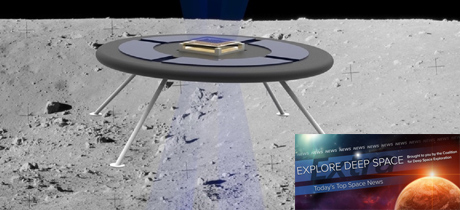In Today’s Deep Space Extra… International Space Station partners plan for 2030 extension following commitment from the White House. The Perseverance rover encounters obstruction. James Webb Space Telescope fully deploys primary mirror in major milestone.
Human Space Exploration
Other ISS partners start planning for extension to 2030
SpaceNews.com (1/9): On New Year’s Eve, NASA Administrator Bill Nelson announced the Biden-Harris White House’s intention to extend operations of the International Space Station (ISS) from 2024 to 2030. Joseph Aschbacher, director general of the European Space Agency (ESA), responded quickly in support. At last week’s virtual AIAA SciTech Forum, representatives from the Canadian and Japanese space agencies said they too will join Aschbacher in starting the processes within their countries necessary to formally approve the extension. Russia’s intent, however, is not so clear due to rising tensions with the U.S.
Space Science
NASA Perseverance Mars rover has crud obstructing its rock sample system
CNET.com (1/7): After drilling for its sixth rock core sample on Mars as December came to a close, NASA’s Mars Perseverance rover encountered a problem. Pebble sized debris are preventing the rover’s robot arm from handing off the sample tube with material from a rock called Issole for sealing and storage in the rover’s chassis. The Perseverance mission team on Earth is working to find a solution.
James Webb Space Telescope fully deploys, Northrop Grumman marks sunshield success
Coalition Member in the News – Northrop Grumman
NASAspaceflight.com (1/9): Two major elements of the James Webb Space Telescope’s (JWST) primary mirror fully unfolded and locked into place over Friday and Saturday, completing the deployments of the observatory’s major components following launch. Ground teams drew praise from Bill Ochs, the JWST’s program manager from NASA’s Goddard Space Flight Center. The observatory must now complete its journey to the Earth/Sun L2 Lagrange point, where it will look out across the universe during its mission life. Over the next several months, engineers will align the optics of the telescope mirrors as well as check out the observatory’s four instruments. Marc Roth, vehicle engineering mechanical and commissioning deployments lead for operations at Northrop Grumman said “the fact that it went off really with no concerns or issues at the end was just fantastic. It’s such an incredible accomplishment… millions of hours and people’s lives dedicated to it to get us to this point… that’s really hard to summarize and give credit to all the work that was done to get us to this point.”
The surface of the Moon is electrically charged, which could allow a hovering robot to explore it
Universetoday.com (1/8): Experts from MIT are developing a concept that could take advantage of the Moon’s electrically charged surface material to permit a robot that hovers to assist astronauts with their lunar exploration in an awkward low gravity environment laden with a dust that sticks to what it touches. Details were published in the Journal of Spacecraft and Rockets.
Luna-25 lunar mission to be Russia’s major 2022 scientific event
TASS of Russia (1/10): Russia is looking to July for the launch of its Luna 25 soft lander mission to the Moon’s south pole. There, it will study its surroundings and especially the potential for the presence of water ice, potentially a resource for human exploration. (Editor’s note: TASS is a Russian government-owned news source).
Weird structures near Earth’s core may be scars from a primordial interplanetary collision
Space.com (1/9): An Australian-led study has identified dense structures known as ultra-low-velocity zones just outside the Earth’s core in the subsurface of New Zealand and Australia. The regions may be remnants of a collision between the Earth and a Mars-sized object believed to have created the Earth’s Moon.
Opinion
Space: One important thing that might retain bipartisan focus
The Hill (1/7): The space domain is essential to daily life, which may help to explain why both space and China’s rise in the field seem to be issues that draw bipartisan interest. The annual global space economy, estimated at $450 billion, is expected to continue climbing for reasons that range from addressing climate change with space solar power to manufacturing and tourism, according to an op-ed from the American Foreign Policy Council’s Richard M.Harrison.
Other News
Arianespace looks to transitions of vehicles and business in 2022
Coalition Member in the News – United Launch Alliance
SpaceNews.com (1/7): Arianespace accomplished 15 launches in 2021, its most since 2000 and including the successful December 25 sendoff of the James Webb Space Telescope (JWST). Revenues for 2021 climbed to $1.4 billion, U.S., a 30 percent rise over 2020. The new year holds promise as well, with the anticipated inaugural launches of the Arianespace Vega C small launch vehicle and the Ariane 6 later in 2022.
Major Space Related Activities for the Week
Major space related activities for the week of January 9-15, 2022
Spacepolicyonline.com (1/9): In Washington, the White House Office of Science and Technology will host the first of two hearings on Thursday regarding orbital debris. The first is focused on remediation. The second, next week, will address mitigation. Meanwhile, the American Astronomical Society (AAS) will virtually host a series of news briefings this week due to the coronavirus pandemic that would have otherwise been hosted in person from Salt Lake City, Utah. Also, the SpaceCom conference is convening in Orlando, Florida on Monday through Wednesday. Speakers include Bob Cabana, NASA’s associate administrator, and Janet Petro, director of NASA’s Kennedy Space Center (KSC). Coalition President and CEO Frank Slazer will appear as a panelist in the conference’s panel entitled “What’s Next? Venus and Beyond” on Tuesday, January 11 at 2:15 p.m. EST.

